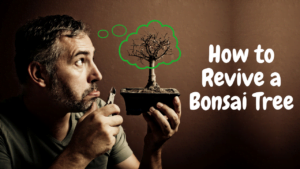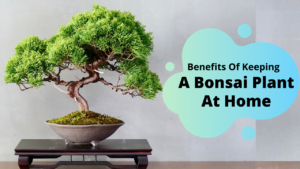Nearly all tree varieties can be grown into bonsai, including fruit trees.
Bonsai trees are miniaturized by applying pruning, wiring, and repotting techniques. However, this technique reduces the size of the tree. But the fruit of the bonsai trees is usually big.
Tree species like apple or lemon have quite big fruits. In comparison, tree species like Crabapple or pomegranate have small fruits.
This article has a list of 24 beautiful fruit trees with their descriptions.
List of the top 24 Bonsai Fruit Trees
| Serial Number | Name | Description |
| 1 | Mango Bonsai | India’s climate is optimum for growing a mango bonsai tree. You can enjoy the fresh, juicy, and delicious mangoes at your own place. This fruit bonsai tree requires full sunlight to thrive well. |
| 2 | Guava Bonsai | Guava bonsai tree flourishes you with juicy green fruits that have many health benefits. Fruits are rich in antioxidants, potassium, vitamin C, and fiber. These bonsai fruit Plants are tropical and require full sun and high humidity. You should water these as their growth level. |
| 3 | Papaya Bonsai | These bonsai trees are known for their beautiful shape and delicious fruit. The fruits are rich in nutritional value, and you can have them for breakfast. Papaya fruit bonsai trees adore the full sun and high humidity. |
| 4 | Jamun Bonsai | These fruit bonsai trees will let you enjoy several Jamuns and a beautiful view simultaneously. Jamun bonsai trees have dark-colored fruits hanging all over the tree, making them a focal point. You should water them consistently to witness optimum growth. |
| 5 | Banana Tree Bonsai | These bonsai fruit trees grows rapidly. These have lush green-colored leaves. It thrives well in sunlight, yet you should protect them from harsh winds. Make sure to water your bonsai fruit plant on regular basis for better growth. |
| 6 | Orange Bonsai | These fruit bonsai trees serve you with tiny oranges. These are low on maintenance and will keep new plant parents away from worries. These bonsai are tropical in nature, demanding a full sun and high humidity for better and healthy growth. |
| 7 | Coconut Bonsai | These bonsai trees depict an island vision easily. These are known to become the talk of the room quickly. They adore tropical environments, i.e., sunlight and high humidity. Unlike other bonsai, you don’t have to prune them frequently. |
| 8 | Pomegranate Bonsai | These fruit bonsai trees make an excellent addition to any space. The red-colored fruit adds charm. These bonsai trees adore sunlight and high humidity. |
| 9 | Apple Bonsai | These bonsai trees make an attractive contrast with big fruits and small leaves. They outshine the other aspects of the space quickly with their unique aerial roots and physical features. You should place them in full to partial sunlight. |
| 10 | Meyer Lemon Bonsai | The fruits of this bonsai tree offer a sweeter taste than ordinary lemons. These plants can thrive well indoors. These make an attractive contrast with evergreen leaves with beautiful purple or white blooms. |
| 11 | Tamarind Bonsai | These fruit bonsai trees are native to Africa and South Asian nations. Tamarind bonsais are known for their medicinal and taste properties. The dense foliage with delicately tiny leaves, and fruit pods with a pulpy texture, make it an appealing addition to any space. |
| 12 | citrus bonsai | These fruit bonsai trees are known for their attractive dark green leaves with tiny fruits hanging around them like cute droplets. These have a unique fragrance distinguishing them from the rest. They adore light and heat. |
| 13 | Black Currant Bonsai | They have unique dark-colored berries in bunches. These are among one the favourite picks of bonsai enthusiasts. They won’t die easily and will flourish you with tasty berries. |
| 14 | Weeping Pear Bonsai | These bonsai trees are known for their unique round crown and dropping silvery foliage. The fruits are small and green, while the flowers are comparatively large and white. |
| 15 | Cherry Bonsai | These are one of the most adored bonsai fruit trees. These are known to capture attention with their beautiful white and pink flowers. If properly cared for, they will repay you with lovely spring flowers and dark black cherries. The edible fruits have a delicious taste. |
| 16 | Olive Bonsai Tree | These fruit bonsai trees grow at a slow rate and have silvery grey narrow leaves. The fruits are edible, yet they are primarily used for oil production. |
| 17 | Fig Tree Bonsai | These are known for their physical features, unique trunk, and aerial roots. They produce fruits in the summer season and grow rapidly. You should water them on a regular basis. |
| 18 | Blueberry Fruits Tree Bonsai | This fruit bonsai tree has unique sky-blue colored berries which are loaded with white blooms. The complementary green leaves make a fantastic addition to settings. If you are keeping your bonsai in sunlight, make sure to water it daily. |
| 19 | Crabapple Bonsai | Crabapple fruit bonsai tree will give you an attractive vibe and tiny berries. This plant makes an appealing addition to any space. You should place your bonsai outdoors for the best results and optimum growth. |
| 20 | Callicarpa Japonica Bonsai | These bonsai trees have purple-colored fruit. They are known to thrive rapidly. You should place them in full sunlight for more fruits to grow. In summers, these bonsai fruit plants grow pink flowers converting them into purple berries later on. |
| 21 | Japanese Winterberry Bonsai | These fruit bonsai trees have dark green serrated leaves with light pink colored blooms. The female bonsai tree produces red berries that last till spring. It prefers staying outdoors all the year long. It thrives well in full sunlight. |
| 22 | Persimmon Bonsai | You can easily train the fruit bonsai tree trunk into single or multiple. These capture the attention quickly by becoming the talk of the room. The tiny fruits add appeal to any space. |
| 23 | Cotoneaster Bonsai | These fruit bonsai trees belong to North Africa, Asia, and Europe. The apple-shaped fruits are of red, yellow, or orange color. These trees need full sunlight and a good amount of water. |
| 24 | Calamondin Bonsai | These bonsai trees have mini orange-colored edible fruits. With the right amount of sunlight, water, soil, and fertilizer, it produces flowers throughout the year. They dislike being in cold temperatures. |
Indoor bonsai plants are a wonderful way to bring a touch of nature into your home or office. These miniature trees offer many benefits, such as improving air quality and reducing stress. With proper care and attention, indoor bonsai plants can thrive for years, adding beauty and serenity to your space. There are many species of indoor bonsai plants available, so do some research to find the one that suits your needs best.
20+ Beautiful Bonsai Fruit Plants
1. Mango Bonsai
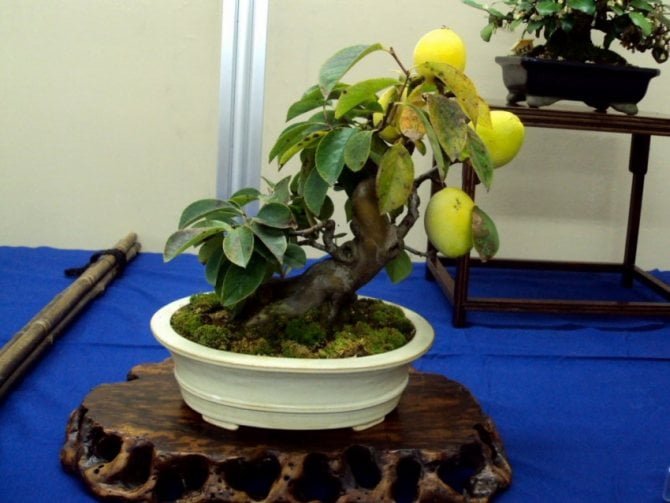
| Botanical Name | Mangifera |
| Location | Sunny place (8 hours per day) |
| Temperature | 70 to 80 degrees Fahrenheit |
| Plant height | 10-15 feet |
This mango bonsai tree is a fantastic choice for maintaining your gardens or home because it tolerates India’s climate very well. This tropical fruit-bearing bonsai tree is among the favourite bonsai fruit trees. Bonsai enthusiasts enjoy the benefits of a Mango tree in your house.
After this bonsai fruit tree bears fruits, the plant will even bring back pleasant memories of eating mangoes you used to enjoy as a child. The plant requires direct sunlight for at least six hours each day. Throughout the growing season or until it starts to bear fruit, generously water once every day.
2. Guava Bonsai

| Botanical Name | Psidium guajava |
| Sunlight | Full |
| Plant height | 10-15m |
The Guava fruit bonsai tree is known for its delicious and juicy fruit. After mango, banana, and citrus, it is the fourth most significant fruit in terms of production and area. Due to its hardiness, it produces a guaranteed fruit even with minimal care and is suitable for rainfed locations as well.
Since the guava is a tropical plant, you can plant it outside in a sunny area. Keep your guava bonsai indoors throughout the winter if you reside in a temperate area. When the tree is growing, water fruit bonsai frequently; throughout the winter, water less frequently. Keep a close eye on the tree during the fall and only water it when the soil starts to dry out.
3. Papaya Bonsai
| Botanical Name | Carica papaya |
| Sunlight | Full |
| Plant height | 9m |
The papaya bonsai fruit tree is grown for its beautiful shape and juicy fruit. These are renowned for their strong nutritional value, delicious flavor, and therapeutic benefits. The fruit is typically fresh and yellow in color. However, some varieties include red and orange fruit flesh.
You can enjoy the fruit of the bonsai tree in the morning as it has digestive-improving enzymes. You can place your fruit bonsai tree in a sunny location because papaya bonsai needs full sun for better growth. You can water the bonsai in three to four days or increase the watering schedule as per requirements. The papaya bonsai needs better fertilizer to promote the quick growth and development of the fruit.
4. Jamun Bonsai

| Botanical Name | Syzygium cumini |
| Sunlight | Full to partial |
| Life span | 100+ years |
| Flowering time | March to April |
Jamun fruit is known for its delicious dark-colored fruit and numerous health benefits. The bonsai fruit tree has a lot of iron and vitamin C, which help raise hemoglobin levels. A sunny location is preferred for the tropical and subtropical plant Jamun fruit bonsai tree. Though, the young plants can endure light shade.
Although Jamun trees can survive in temperatures as low as 12 degrees Celsius, they prefer temperatures between 20 and 32 degrees Celsius. While flowering and producing fruit, the Jamun bonsai plant might require a dry climate.
During the growing season, constant watering is necessary for good growth. Alternatively, you can alter the schedule according to the growth of the bonsai.
5. Banana Tree Bonsai
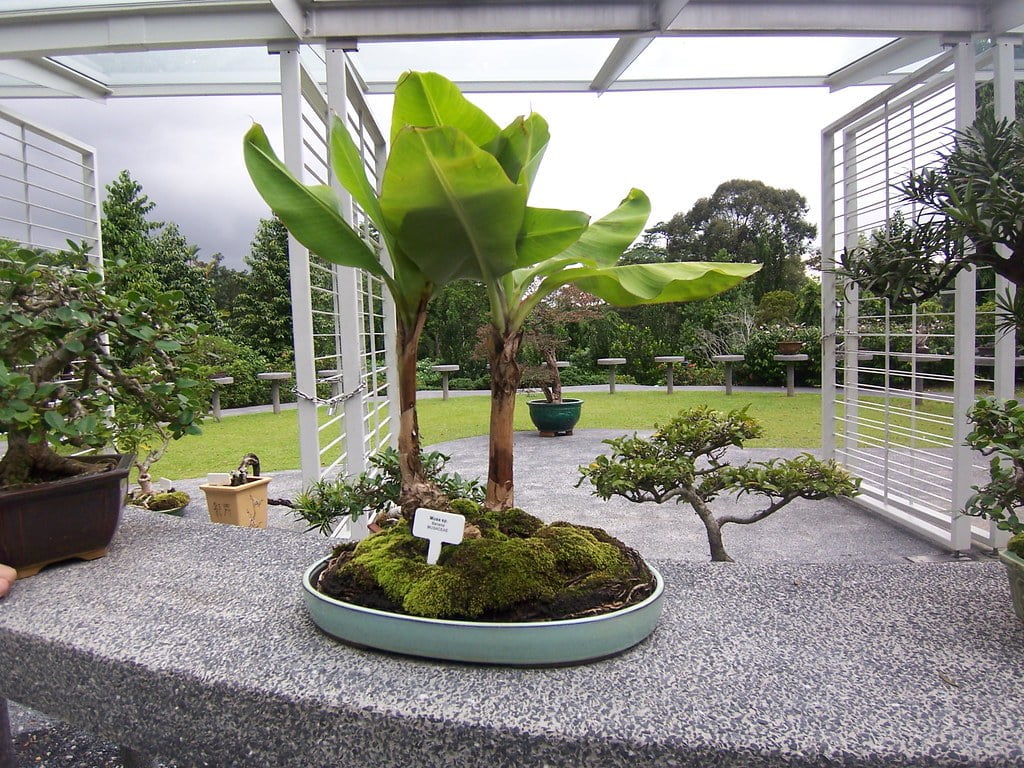
| Botanical Name | Musa spp |
| Height | 2-4m |
| Sunlight | full |
| Fertilizer | High Potassium fertilizer is preferred |
Banana is a lush green fast-growing plant. A banana tree grown in the pot gives the same large dramatic leaves and, in some cases, same size flowers as developed on the ground.
It requires a lot of sunlight but should be protected from winds. Banana bonsai loves moisture, so water it regularly.
6. Orange Bonsai

| Botanical Name | calamondin orange |
| Sunlight | Full |
| Plant height | 9m |
Who doesn’t love oranges? The compact circular shape and bright orange color make an appealing addition to any space. Because they are tropical plants, orange trees require constant warmth and sunlight. It means that you should set up your bonsai tree outside in a sunny location throughout the summer.
You should water the soil frequently enough to prevent the orange fruit bonsai tree from becoming very dry, but not so frequently that water remains in the pot all the time.
7. Coconut Bonsai
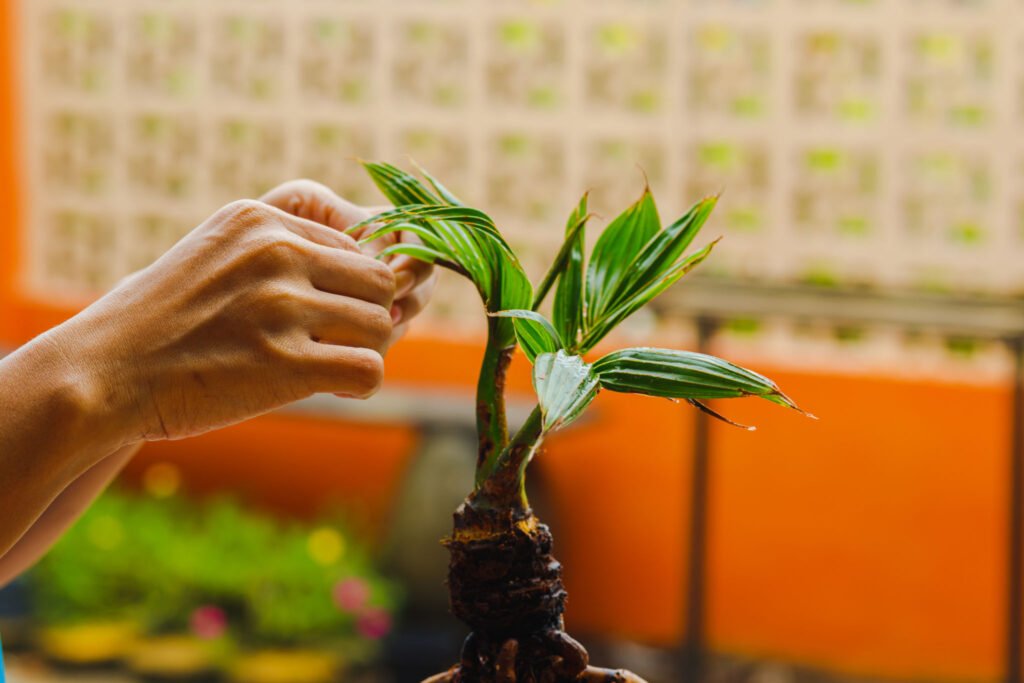
| Botanical name | Cocos Nucifera |
| Height | 30 m |
| Location | Sunny spot |
| Leaves | 4m |
| Life span | 60-80 years |
You haven’t even thought for a second that the coconut fruit bonsai tree would be there on the list. Right? But these are one of the favorite picks of bonsai lovers. They are adorable and excellent conversation starters.
This bonsai fruit tree is simple to maintain and perfect as a palm-sized work of art. You won’t have any issues as long as you give it enough water, a sunny position, and regular fertilization.
Coconut trees ideally grow healthy in a tropical and humid climate. Even a light sprinkling every few days will make coconut bonsai resemble an island. The coconut tree doesn’t need as much pruning as other trees, making it an easygoing companion.
8. Pomegranate Fruit Bonsai

| Botanical Name | Punica granatum |
| Height | 24 inches |
| width | 4-6 inches |
| Sunlight | Full to partial sunlight |
| Flowering time | 3 months |
| Lifespan | 200+ years |
Pomegranate tree prefers a sunny location. An ideal temperature for the tree is above 40 degrees Fahrenheit. Water your bonsai pomegranate to maintain its soil moisture. You can reduce watering during winter.
9. Apple Fruit Bonsai

| Botanical Name | Clusia Rosea |
| Location | Sunny |
| Fertilizer | Balanced Fertilizer |
| Flowering Time | Summer |
The leaves are small on the Apple bonsai tree, but the fruit is big. Apple Bonsai is called Pitch apple or Monkey apple tree. It is the native of the tropical region of America.
It grows in various bonsai styles with dark green leaves and aerial roots. And in summer it produces white and pink flowers. After the flower falls, it starts to grow miniature apple fruit.
Apple Bonsai tree should be placed in a sunny location. It can also be placed outdoor in full sun or semi-shade. Apple bonsai requires regular watering and more when the tree is growing fruit.
10. Meyer Lemon Bonsai

| Botanical Name | Citrus meyeri |
| Height | 14-18 inches |
| Width | 4-6 inches |
| Sunlight | Full |
| Flowering Time | Spring |
| Lifespan | 50 years |
They are easy to grow as indoor plants. Year around tree produces a fresh and flavourful harvest of lemons.
Meyer lemons require direct sunlight, so try to place them near the window in a southward direction.
Whether this plant has fruits or not, it still looks beautiful. As it has evergreen leaves with gorgeous white or purple flowers.
The Meyer lemon offers a sweeter taste compared to traditional lemon.
This plant requires full sunlight to bloom and fruit reliably. But it can tolerate some shade. In watering also, it can handle an occasional period of dryness.
11. Tamarind Bonsai
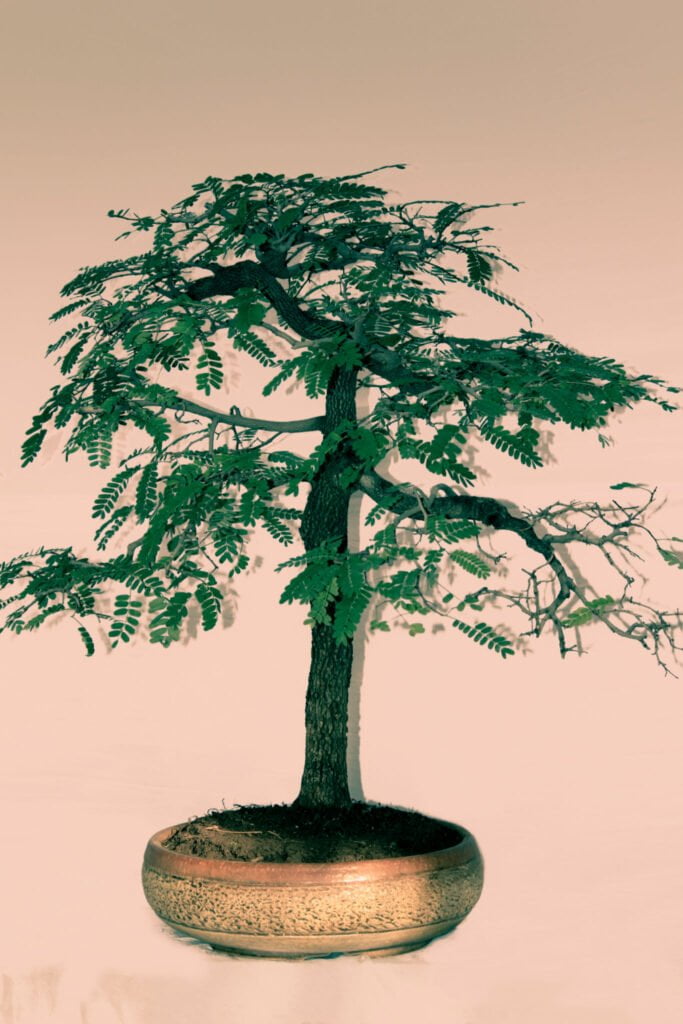
| Botanical Name | Tamarindus indica |
| Sunlight | Full |
| Plant height | 9m |
The tamarind fruit bonsai tree is a tropical perennial tree that is widely cultivated for its fruit and shade. The tree is primarily grown in Africa and South Asian nations for its medicinal and taste properties. The bonsai fruit tree is also renowned for its upright growth, dense foliage with delicately tiny leaves, and fruit pods with a pulpy texture.
These trees are low on maintenance, making it easy for plant parents. This tree is the perfect complement for house decor and aesthetic enhancement because of its rugged trunk, delicate leaves, and pulpy fruits. Additionally, these bonsai trees provide the most lifelike indoor experience.
12. Citrus Fruit Bonsai
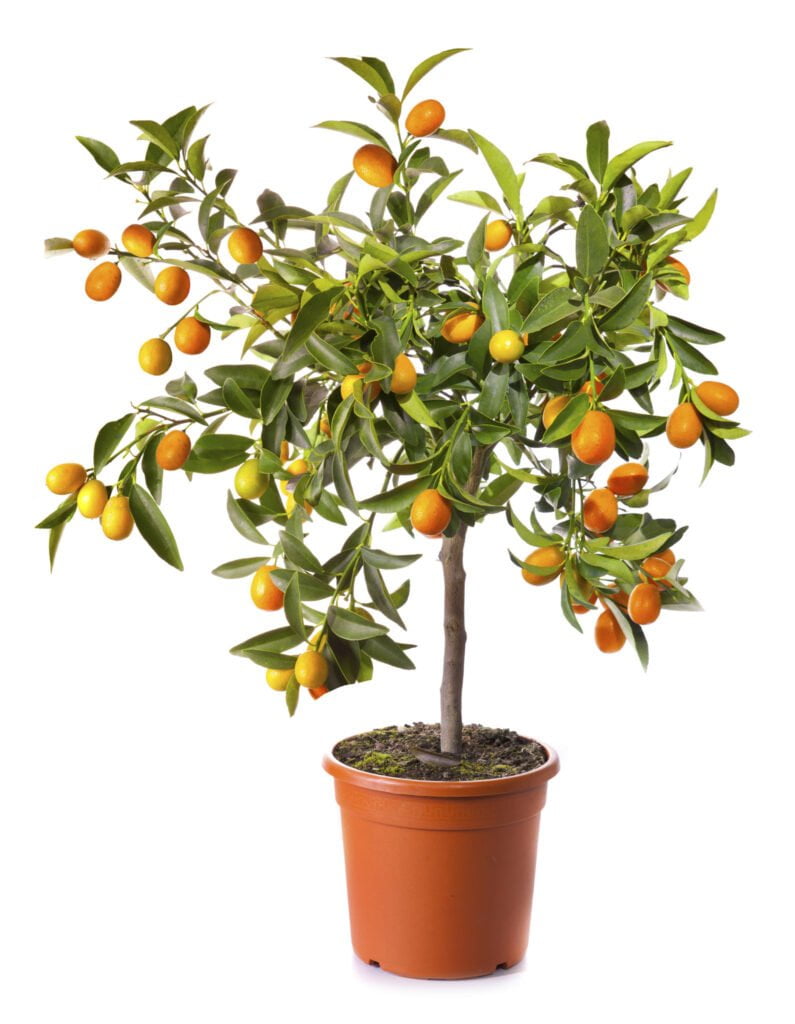
| Botanical Name | Citrus sinensis |
| Sunlight | Full |
| Plant height | 6m |
Evergreen citrus fruit bonsai tree has glossy, dark-green leaves with little, wing-like appendages on the stalks. You can easily find tiny thorns on various species. Citrus plants yield attractive yellow or orange fruit and fragrant white blossoms. The cultivar affects the fruit’s size.
Citrus plants enjoy light and heat. You can leave these plants outside all year long in warm climates. The citrus bonsai tolerates brief periods of drought but requires regular watering during the summertime. It dislikes being standing in the damp soil. You should water your bonsai thoroughly as soon as the soil surface becomes dry.
13. Black Currant Bonsai
| Botanical Name | Ribes nigrum |
| Sunlight | Full |
| Plant height | 7m |
Do you want a bunch of fruits at a single time? This bonsai fruit tree will win your heart with a single glimpse. The dark-colored fruits look attractive and complement the space. Unlike other fruit bonsai trees, this one is not prone to drying out and cracking. The fruit bonsai tree will repay you with an abundance of berries and an ornamental appeal if you only give it enough sunlight and water!
14. Weeping Pear Bonsai
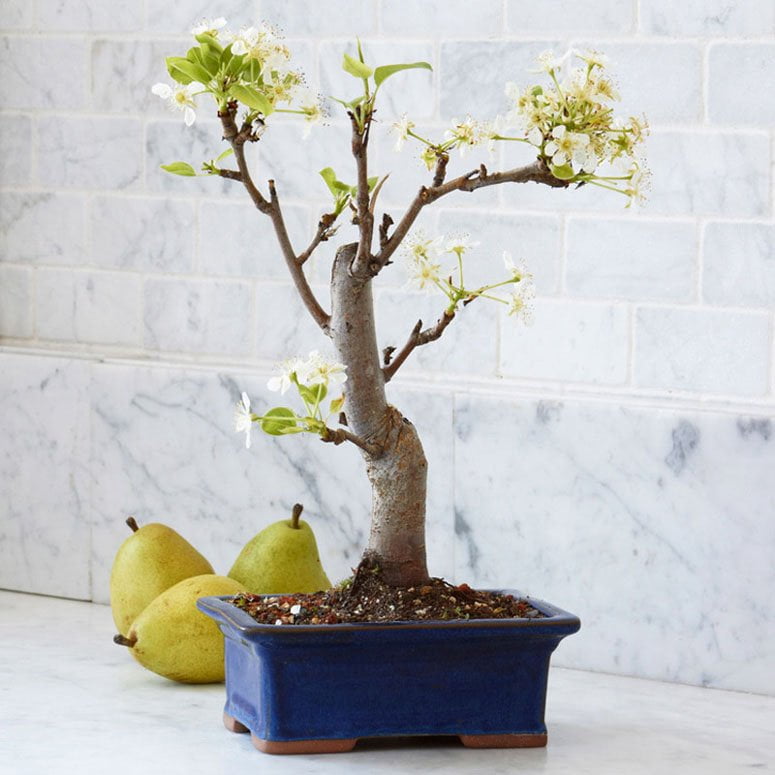
| Botanical Name | Pyrus Salicifolia |
| Height | 10-12 m |
| Flowering time | Spring |
| Sunlight | full |
Weeping pear is widely grown as an ornamental tree. The tree is deciduous and has a round crown. It has drooping silvery foliage.
The flower is large and in white color with black-tipped stamens. It produces small green fruit that is inedible. The weeping tree is widely cultivated in garden areas.
15. Cherry Bonsai
| Botanical Name | Prunus Avium |
| Flowering time | Spring |
| Location | Sunny place |
The cherry is famous for its beautiful white and pink flowers.
Cherries belong to the Prunus genus.
It is an evergreen tree with lovely spring flowers and dark black cherries. Almost any kind of cherry tree can be used for bonsai. Just choose the tree which has gorgeous foliage and edible fruit.
The cherry needs a sunny place that is protected from strong winds. During summer, it can be wise to provide partial shade.
Cherries are frost-hardy but should be protected in cold temperatures. They need more water during the growing season, and rootball must not dry out. Mainly when flower and fruit develops.
16. Olive Bonsai Tree
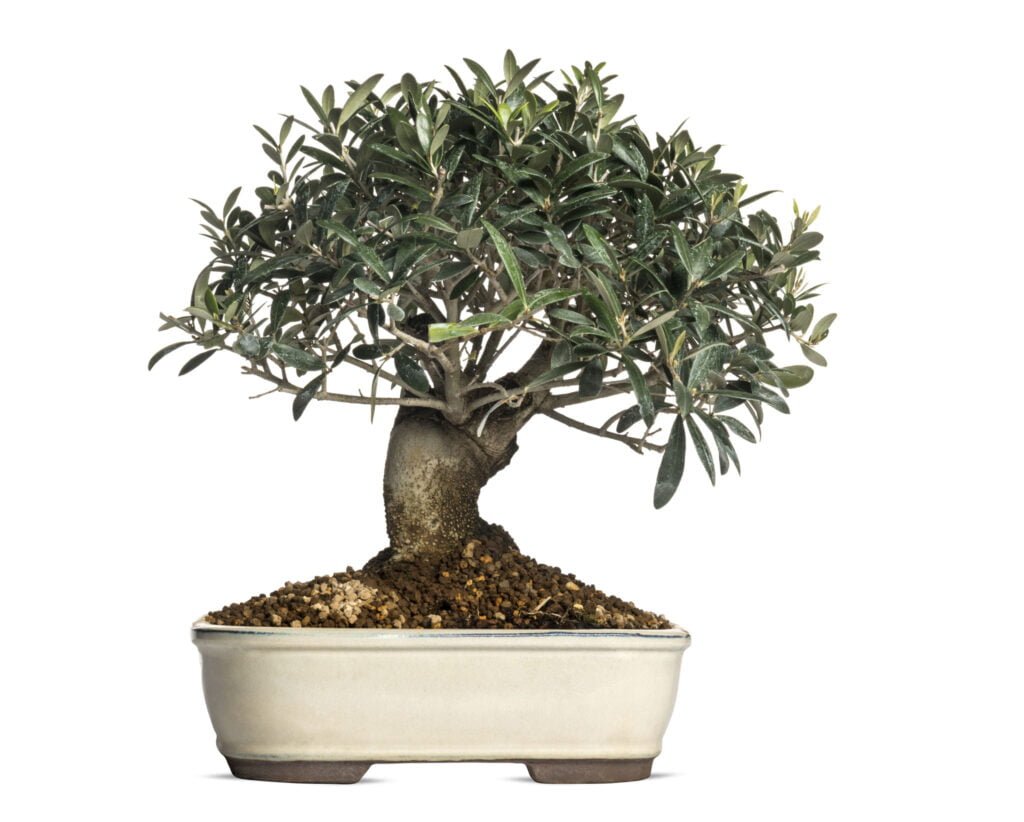
| Botanical Name | Olea europaea |
| Sunlight | Full |
| Height | 10-20m |
Olive bonsai is an evergreen tree or shrub. It has silvery grey and narrow leaves. The growth of an olive tree is slow, but it can live up to hundreds to thousands of years old.
The tiny yellowish-white flower is followed by green drupes, which later turn black when ripe.
Olive fruits are edible when they are watered and kept in brine for some time, but primarily olive fruits are used for producing oil.
The olive bonsai tree is easy to care for when placed in a cold climate.
17. Fig Tree Bonsai
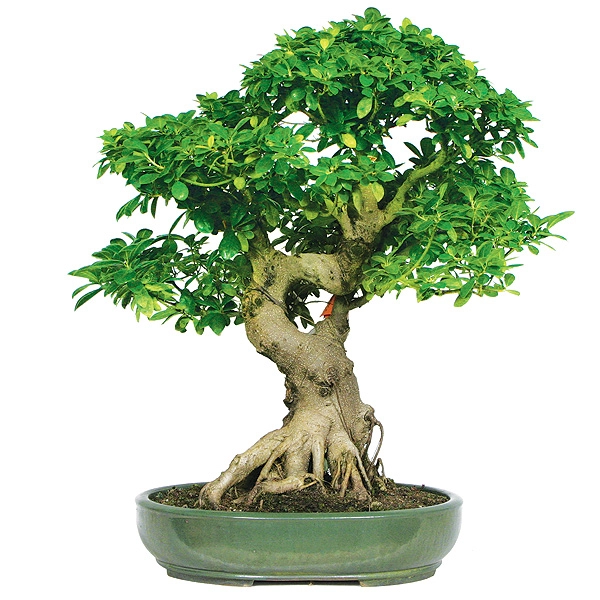
| Botanical Name | Ficus Carica |
| Height | 7-10m |
| Sunlight | Full |
It has been characterized as the most exciting trunk, small leaves, and many aerial roots.
This Fig tree produces fruits in summer. As it is a deciduous bonsai tree, it has rapid growth, but regular pruning keeps it in the ideal size.
A fig bonsai requires regular water. The root ball should not be dry or too moist. Moderately dampening is perfect.
They produce fruit regularly. Depending upon the Ficus species, the size of the fruit varies.
18. Blueberry Fruits

| Botanical Name | Vaccinium sect. Cyanococcus |
| Flowering time | Spring |
| Fruit size | half inches |
| Sunlight | Full |
The tree is loaded with white flowers, followed by delicious blueberries. The berries are sky-blue in color. And light green foliage remains for a long season. However, this foliage may turn red color during fall.
Its small glossy leaves, gnarly trunk, and slow growth make this one of the best bonsai fruit plants. Also, this is a supremely heat-tolerant tree.
In blueberry fruit, tree water can’t be neglected. The soil should not dry out if your blueberry bonsai receives full sunlight, then watering it once a day is needed.
19. Crabapple Bonsai
Crabapple has small berries on it. These small size berries are often called Shohin. It is one of the best bonsai fruit to display. Besides being edible fruit, its other attractive feature adds beauty to the place. The word Crabapple includes more than 50 species of shrub and deciduous tree.

Following are Some interesting facts about Crabapple,
| Botanical Name | Malus |
| Height | 6-10 inches |
| Width | 2-3 inches |
| Sunlight | Direct Sunlight |
| Flowering Time | Mid-spring to late spring |
| Life Span | 40 years |
The most popular type of Crabapple is,
- Malus Halliana
- Malus zumi
- Malus Toringo
- Malus Sylvestris
- Malus Baccata
- Malus cerasifera
- Malus Floribunda
The ideal location for crabapples is outdoor because it requires sufficient sunlight and good airflow. But this plant does not like extreme heat or cold. So try to keep it indoors when the temperature dips. Also, when producing flowers or fruits, Crabapple requires more watering.
20. Callicarpa Japonica Bonsai Fruit tree
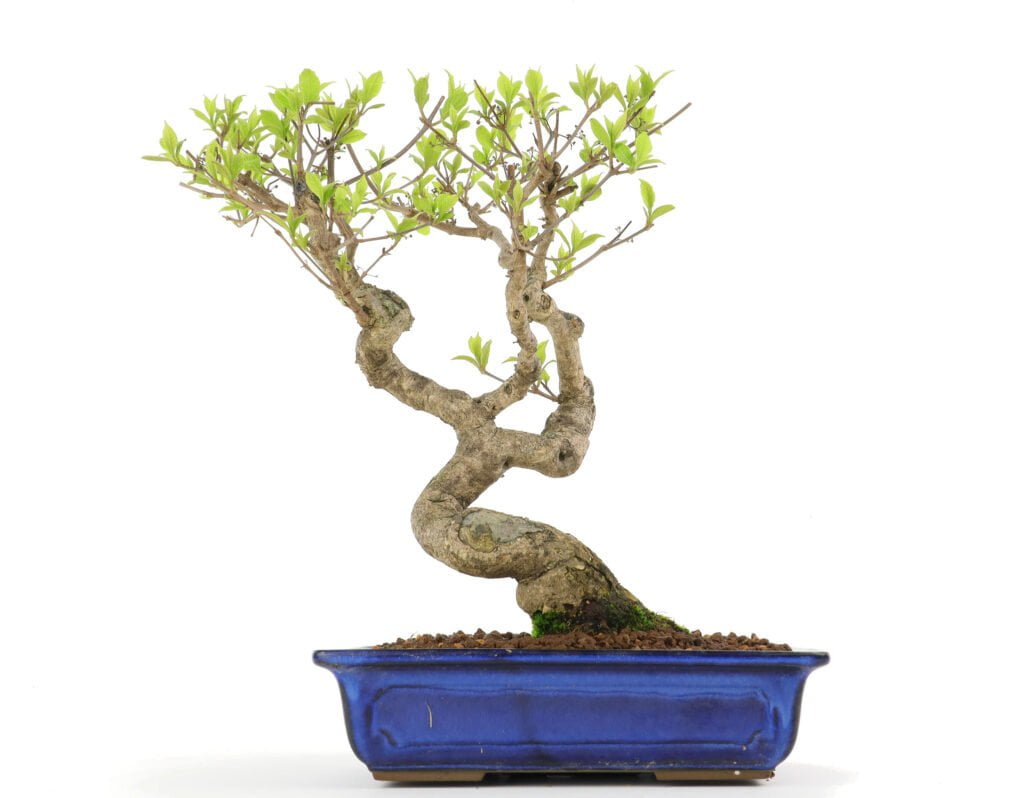
| Botanical Name | Callicarpa Japonica |
| Height | 5-6 feet |
| Sunlight | Full |
| Flowering Time | Late spring and early summer |
This tree has tiny purple fruit on it. They are one of the fast-growing trees. For flowering and fruiting, it requires more sun. If you place this tree in the shade, it will limit the number of fruits.
During early summer, the tree starts to grow the pink flower. Later, the pink flower gets converted into purple berries. Callicarpa Japonica fruit comes under the drought-tolerant category. But if you don’t water it during late spring and early summer, you will cut the amount of flowering.
If the plant starts to get dry, the leaves turn yellow.
21. Japanese Winterberry
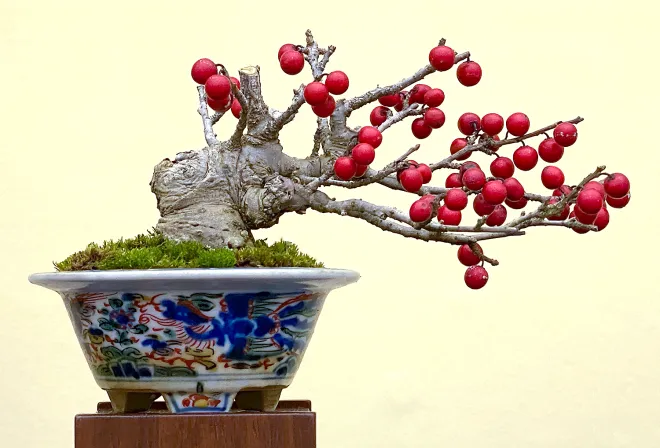
| Botanical Name | Ilex Serrata |
| Height | 4m |
| Sunlight | Full |
| Flowering Time | Spring |
The Japanese winterberry is a deciduous shrub or tree. They have dark green serrated leaves with light pink flowers. The female tree grows red berries that last till spring.
It is an outdoor tree and should be placed outside all the year. This is because the tree requires a lot of sunlight to produce fruit. But it should be protected from intense heat during summer.
It is necessary to have a male and female tree simultaneously to ensure pollination; otherwise, the tree won’t bear fruits.
You may need birdcages because birds like berries and can steal them as soon as it starts to grow.
22. Persimmon Bonsai Tree

| Botanical Name | Diospyros Kaki |
| Height | 4.5 to 18m |
| Flowering time | late spring or early summer |
A unique feature of Persimmon is that it can be trained into a single or multiple trunks. A cultivar named gold apple (Diospyros decandra) and Indian Persimmon (Diospyros peregrine) is popular in bonsai. And are displayed in the Buddhist temple of Thailand.
23. Cotoneaster Bonsai
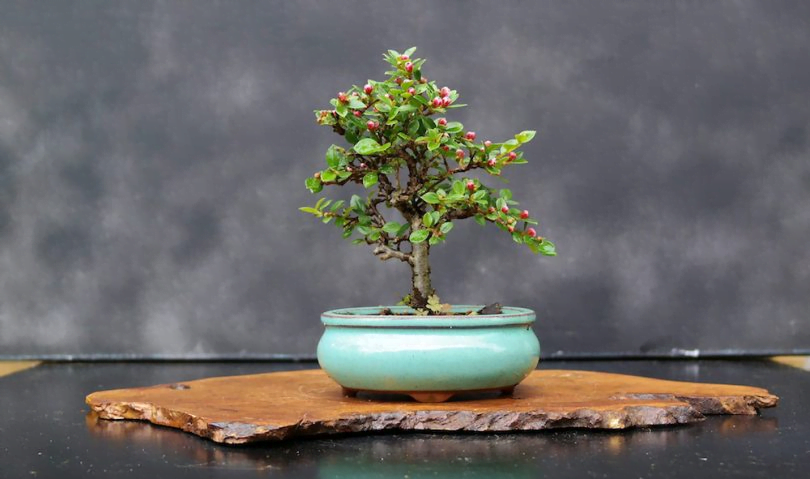
| Botanical Name | Cotoneaster |
| Flowering time | Spring |
| Sunlight | Full sun |
Cotoneaster is a small tree native to North Africa, Asia, and Europe. The tree has a small dark and glossy green leaves with tiny white flowers. In autumn, it produces red, yellow, or orange, apple-shaped fruit.
It requires full sun during the growing period, but in the hottest summer, semi-shade is needed. The cotoneaster requires a lot of water, but it can survive a short period of drought.
Even some cotoneaster trees whose leaves have been died due to lack of water can recover and produce new leaves.
24. Calamondin Bonsai

| Botanical Name | Citrus microcarpa |
| Height | 15-20 feet |
| Sunlight | full |
It is the miniature version of the citrus fruit called Calamondin Orange. It can grow up to the height of 15-20 feet, but with regular pruning, you can maintain its size.
Also, it is capable of producing flowers throughout the year. And beautiful little oranges are edible too.
As this bonsai fruit grows in less soil, it requires the proper amount of fertilizer to give healthy nutrients to trees.
Orange trees are not tolerant to cold air. Therefore, they must be kept indoors during cold months.
With the proper care, it can produce fruit of the same size as its counterpart
Frequently Asked Questions
Ques1: Which fruits can I make as bonsais?
Ans: You can grow any species of tree as a bonsai. Although some of the most popular bonsai trees are crabapple, many types of Citrus, papaya, olive trees, and pomegranate.
Ques2: Can I eat the fruit from the bonsai tree?
Ans: Yes, fruit from the bonsai fruit tree is edible. There is no difference between the fruit from a bonsai tree and fruit from a regular-sized fruit tree. A fruit bonsai tree is not a genetically altered tree. One thing you have to consider is how much chemical fertilizer you have used on your bonsai. Use organic fertilizer on your bonsai, and you are good to go.
Ques3: How long does it take a fruit tree to grow into a bonsai?
Ans: Although it takes at least three years for seedlings to get big enough to begin shaping, this is advantageous because it immediately gives you complete control of your Bonsai tree. Or, if you don’t want to wait that long, you can purchase a bonsai tree from our store and enjoy fruits much earlier.
Ques4: How long does a bonsai fruit tree live?
Ans: A fruit bonsai tree can easily survive over 100 years old if you care for them properly. Some bonsai are known to live up to a thousand years, or even for centuries passing down to new generations!
Ques5: How to fertilize bonsai fruit trees?
All bonsai need fertilizer for healthy growth. The substrate they have in the soil is not enough to get the nutrients and produce fruits. You don’t have to use a particular fruit species fertilizer, just pick one that is made for bonsai. A slow-release fertilizer is better to use because you can simply spread it a little and it will continue to provide the plant it needs for months.
Fertilize as you would typically do for the species you’ve selected, generally before spring, after spring, and also at the end of summer. Withhold from adding any fertilizer in the weeks before the fruits ripen. This can provoke the fruits to drop. Sometimes it’s suggested that extra potassium will give fruit formation, but it’s optional.
Fruiting bonsai trees require each of the primary plant nutrients – nitrogen (N), phosphorus (P), and potassium (K) – to develop. a bonsai needs all of these macronutrients to thrive. It will take up what it needs and the leftovers will drain out through the mess of the pot when you water. That doesn’t imply that you can use way too much fertilizer and simply let the excess wash out – this can be harmful, causing sodium levels in the soil to rise to scary high levels. One exception is if you see the fruits are little and underdeveloped, or they don’t begin developing at all. If this happens, you should test your soil to see if its potassium levels are low. You can do that by sending your soil sample to your local agricultural extension office.
Ques6: How to prune fruiting bonsai?
Pruning is something that every gardener who is growing a bonsai must know, but it’s extremely crucial for those who are cultivating bonsai fruit trees. Not only do you have to stick to the traditional directions of pruning, but you must prune to promote perfect fruit construction. That indicates you need to maintain both the requirements of your species and the shape of your tree in mind.
For example, if you’re making a blueberry bonsai, be conscious that the best berries start to develop on canes that are one to four years old. After that, they almost cease fruit production. Skilled bonsai owners create a big, prominent trunk with multiple canes emerging from the top to form a canopy, then trim away a few matured canes each year so the plant maintains its fruit production while keeping a pleasing shape.
For an apple tree, you have to prune in the winter months to create a beautiful shape that will also help the fruits that form.
Overall, that means you want a big, solid central trunk and only a few short, sturdy stems expanding from the trunk for bonsai fruit trees.
Conclusion
The bonsai fruit tree has gorgeous foliage along with edible fruits. Like any other tree species, the bonsai can be made out of tree species, including fruits. Some may not bear edible fruits, but they have gorgeous aesthetic value and can be helpful in some other ways.
The most popular bonsai fruit trees are Crabapple, citrus varieties, olive tree, and pomegranate. But you could also try blueberry bonsai and cherry bonsai as they have delicious fruit.
Related Articles
- Bonsai for Beginners in India [Update 2024]
- 15 Best Plants for Front Door Entrance India | Auspicious plants for front door
- 10 Study Table Decoration Ideas That Will Make You Love Learning
- Revive Your Bonsai Tree with These Proven Techniques!
- Top 15 Benefits of Bonsai Plants that will Make your Life Awesome
- Top 10 Indoor Plants for Cafes to Enhance Decor & Comfort





